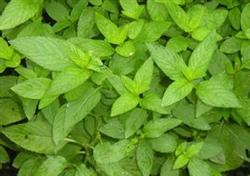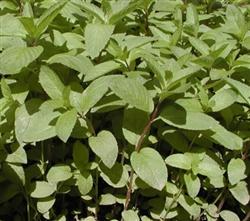Comprehensive control techniques of mint rust

Peppermint is a well-known medicinal plant at home and abroad, the whole plant is used as medicine. It is produced in Jiangsu. In recent years, with the adjustment of rural planting structure and the needs of the market, the planting area of peppermint in various parts of Jiangsu has been expanded, but in the process of growth and development, it is often damaged by rust, which not only seriously reduces the yield, but also affects the quality. the occurrence and control methods of peppermint rust are introduced as follows: first, symptom characteristics: rust is a common and important disease of peppermint. Mainly for damage to leaves and stems. At the beginning of the disease, yellow and orange micro-raised blister spots were produced on the leaves or tender stems, and sometimes several blister spots combined into large spots and blister epidermis ruptured, spreading yellow, orange or ferruginous powder (summer spores of the pathogen). In the later stage of the disease, the disease produced black powder (the winter spores of the pathogen), the damaged leaves grew poorly at the initial stage, and the photosynthesis was seriously affected due to the attachment of yellow spores on the leaf surface. Most of the leaves dried up, resulting in early defoliation. After the disease of the tender stem, the stem above the diseased part wilted at first, and then the tender stem withered and died. Peppermint rust also harms many kinds of medicinal plants such as Panax notoginseng, Yuanhu, Atractylodes macrocephala, Angelica sinensis, Fritillaria and so on. Second, the occurrence rule: the pathogen overwintered with winter spores on the diseased remains of the soil, and the winter spores could also adhere to the seeds for the winter. In the following year, winter spores germinate and cause damage. From late May to late June, in case of continuous overcast, rainy or dry weather, it is very easy to get sick, spread quickly and cause serious damage, and summer spores are spread by the wind. The distance of transmission is as little as a few kilometers or dozens of kilometers. Therefore, once rust occurs, it often has a wide range and large area. Third, prevention and control methods: 1. Carry out crop rotation. That is, crop rotation with rust pathogen non-host crops for more than 3 years. two。 adequate manuring. During the growth period of peppermint, the application of nitrogen fertilizer should be avoided, and the application of phosphorus and potassium fertilizer should be properly increased to promote the steady growth of plants and enhance disease resistance. At the same time, attention should be paid to field drainage to prevent stains. 3. According to the introduction of professional households who grow in large areas, spraying 1DV 100 Bordeaux liquid before the onset of the disease has a better protective and preventive effect; when the disease occurs, it is sprayed 1200 times, and 65% Dysen zinc is 1200 times, and the effect is also very good. If the disease is serious, it can be sprayed once every 10 days, twice continuously.
- Prev

Three-dimensional cultivation of soybean Gastrodia elata
In order to develop the local economy, increase farmers' income and successfully introduce the demonstration cultivation of spice crop peppermint, we found out the key technology of peppermint planting and accumulated experience for large-scale popularization. 1. Seedling raising and rhizome propagation. The root cultivation was carried out in late April or late August. Choose to grow sturdily in the field.
- Next

Breeding techniques for summer propagation of peppermint
1. Choose a good breed. The varieties with strong growth, strong disease resistance, high brain content and pure fragrance should be selected in summer propagation breeding of peppermint. Asia 39 and Fuyou 1 are generally selected. two。 Breeding time. Generally speaking, the growth of mint in the first crop goes into the flower bud stage. The south is around June and the north is around July. 3. Prepare the ground. Choose the terrain.
Related
- Fuxing push coffee new agricultural production and marketing class: lack of small-scale processing plants
- Jujube rice field leisure farm deep ploughing Yilan for five years to create a space for organic food and play
- Nongyu Farm-A trial of organic papaya for brave women with advanced technology
- Four points for attention in the prevention and control of diseases and insect pests of edible fungi
- How to add nutrient solution to Edible Fungi
- Is there any good way to control edible fungus mites?
- Open Inoculation Technology of Edible Fungi
- Is there any clever way to use fertilizer for edible fungus in winter?
- What agents are used to kill the pathogens of edible fungi in the mushroom shed?
- Rapid drying of Edible Fungi

